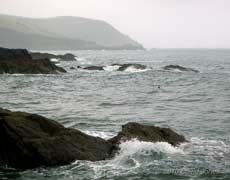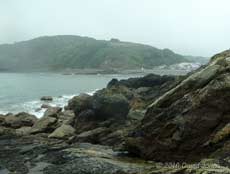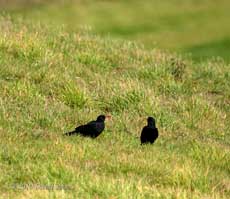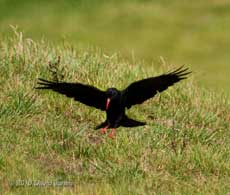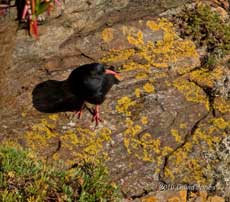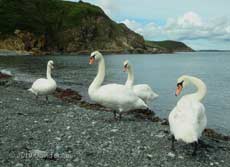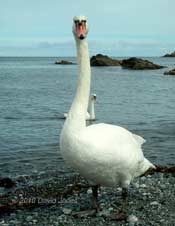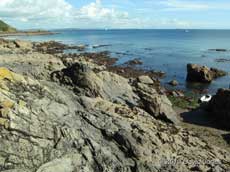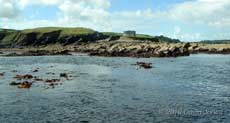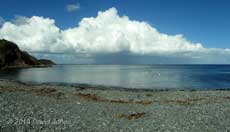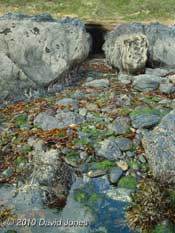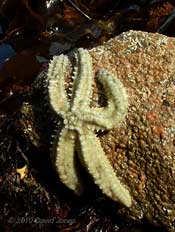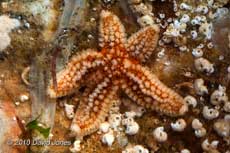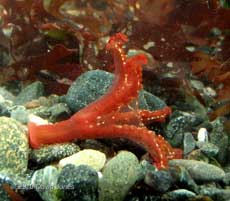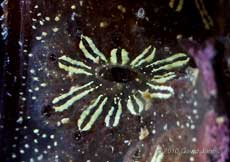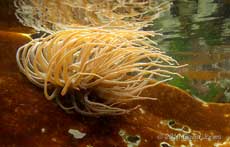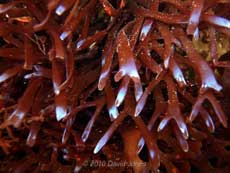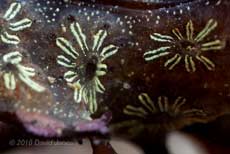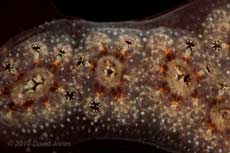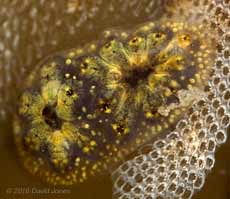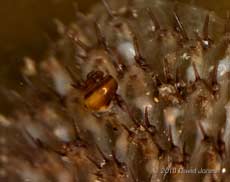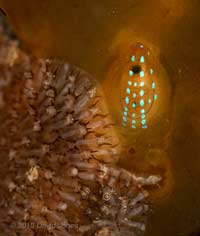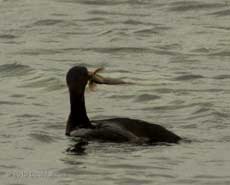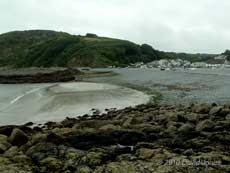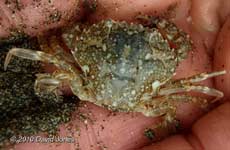Go to the last entry on this page .....Go to previous entryAn attempt to get the diary going again, having 'lost' all of August to the frustration of tiredness. Amongst other things I didn't pick up a camera for several weeks. It didn't help that the month was also a disappointment weather-wise, with a distinct lack of sunshine. That seems to be becoming a regular feature of the summer holiday period. During the month we said goodbye to our Land Rover Discovery, and bought a Honda CRV instead. As we slipped into September the weather changed, giving a hint of an 'Indian Summer', just in time, so we thought, for our second trip of the year down to Cornwall, to our usual spot on the Lizard. 5 September - The first big road test for the CRV as we headed to the West Country, complete with Kayak and cameras! After the spell of warm sunny weather that started the month the journey turned out to be the wettest that we can remember for many years!
6 September - A wet morning, but I was determined to head for the beach at Porthallow and take a walk along the rocky foreshore to the right of the cove. In the days before we arrived the winds had been from the south-east, and there is always the possibility of interesting things being washed in. My hopes were raised when I spotted some old timbers with a small number of Goose-barnacles. Unfortunately, they were all dead - the timber must have been washed up at least several days ago.
On a previous visit it popped its head up out of the water right next to my kayak! The choppy sea was due to south-easterly winds that had been occurring for several days.
Although this photograph may suggest that it was just misty, by the time I got back to the car I was soaked. However, just being able to walk on these rocks again made it all worth it!
Once I sorted myself out we headed over to Lizard Point for lunch down at the Polpeor Café. With the rain continuing to fall, the place was full of very damp people and steamed up windows. We sat by a table that faced west, and as we ate a typical Lizard transformation took place. Through the wet windows I caught a glimpse of brightness, and by the time we finished our meal and left the café the skies had turned from grey to blue. The afternoon remained sunny and became even brighter as far as I was concerned when I spotted a pair of Choughs feeding on the cliffs to the west of the point, near their nesting cave.
By the time I collected my camera from the car they had moved from the cliff to a field where they spent the next hour feeding, and where I was able to get a few rather distant photographs,
the lack of rings on their legs confirming that this is probably the pair of adults that were the first to return here back in .
After a five minutes or so of feeding they were disturbed by the approach of a number of Jackdaws, and flew off to the cliffs where I managed to get one more shot before I headed back to the cafe.
By the time we got back to the bungalow I was shattered - too tired to enjoy the sight of a brilliantly clear sky after dark, with the Milky Way standing out in a way that we never see at home. There was an interesting item in the evening news bulletins - it seems that a Scottish study into Chronic Fatigue Syndrome in children has found more evidence of a viral connection with the condition that has been so frustrating for too many years. No cure in sight yet, but at least this study gives some hope that some small progress may be made towards that goal.
7 September - Overnight it seems that some heavy showers passed over us, along with rumbles of thunder, although the day turned out dry and sunny day, although much of the morning was spent in Helston, the local town and we didn't get to the beach until the afternoon.
The wind has now moved around to the south-west, meaning that the sea was flat calm at Porthallow. However, by then I was too weary to risk heading out on the canoe. Instead, we enjoyed the unusual sight of four Swans in the cove - we can't recall seeing them there before,
and one seemed to be very inquisitive, although with no aggression - I was sitting on the gravel no more than a couple of feet from it when I took this photograph.
8 September - On another sunny morning, and with the tide very low (lowest tides of the year over the next couple of days) we headed back down to Porthallow and I got out on my kayak for the first time this holiday.
It was a case of heading off along the usual bit of coastline, stopping off several times to beach-comb in coves.
With the south-westerly breeze sometimes providing a following wind I got as far as Nare Point and its Coastal Watch station. One of the volunteers there told me that there is actually a pair of seals living on this bit of the coast although I saw no sign of them today.
During the trip I found a large Dogfish (>3ft) tangled in some netting. It was still very much alive and headed off under rocks when freed. This afternoon/evening I'm absolutely shattered - but it was worth it!
While we relaxed afterwards it was interesting to contrast the sunny conditions we were experiencing with a line of heavy showers that was affecting the Cornish coast to the east of Falmouth Bay during much of the afternoon.
9 September - Another bright, sunny morning had us heading back down to Porthallow for the low tide that would take place just before noon. With a couple of hours to wait once we had arrived, and with the sea flat calm, I couldn't resist getting out on my kayak again. Unlike yesterday, soon after I paddled out of the bay a line of cloud arrived over us rather than the lands across the bay. Fortunately we had just a few spots of rain all day.
Still weary from yesterday I didn't go far this time, just as far as the caves. At other times it's possible to paddle into this one (as well as a couple of others), but with the Spring tide approaching its lowest point there would have been a long wait to do so at this time.
When I returned to shore to explore a bit of the shore at low tide I found myself struggling to keep going - thank goodness that it is much easier to put the kayak onto the roof of the CRV than it was onto the Discovery roof rack! Anyway, I managed to take a few photographs before I had to pack the cameras away too and we headed off to Lizard Point for a meal.
To the right of the gravel beach there are just a few rock pools, but the rocky lower shore provides a good spot to search when you are in a good mood! First, the largest starfish that I've found during our Cornish holidays, measuring in excess of 15cm across. it is Marthasterias glasialis, basically a sublittoral species made accessible by the Spring tide.
This is a much smaller individual was only around 4cm across. Covered with what look like tufts of spines I think it is the Common Starfish (Asterias rubens).
It was attached to red seaweed close to a foot below the water at low tide. Unfortunately, when I collected the bit of seaweed the jellyfish detached itself. I think it is Lucernariopsis campanulata, a largely sublittoral species.
Each of the eleven arms of this star represents one individual. Each organism has a small oral siphon at the outside edge of the star, while all eleven individuals share a central exhalent siphon
10 September - Having learned my lesson yesterday, while we headed down to Porthallow again, this time the kayak stayed on the car! It was a largely cloudy day with a strong but quite mild wing blowing down the valley leading to the cove, and the sea was more or less flat calm.
To start with, a Dreadlocks Anemone waving about in the slight surges still present in the calm water,
and the iridescent blue tips of the Carragheen seaweed, although the blue colouring doesn't come out as well as I would like. Perhaps I'll try again next week.
Another picture of the colonial sea squirt Botryllus schlosseri.
My guides describe the species as rather variable, but this one certainly looks very different. If you view the large image you can also see a second picture of the central grouping that shows different oral siphons open as the individuals draw water through their bodies.
In this example the individuals appear to be more clearly defined as well as having a different colouring.
I had hoped to photograph some living bryozoans, but wasn't successful today. However, I did spot this tiny gastropod that appeared to be feeding on a patch of bryozoans. This is a species that I'll have to investigate further when I get home and have internet access once again.
As I watched for bryazoan activity on a piece of Laminaria frond I spotted some almost luminous blue spots that stood out against the brown background despite being very small (less than 3mm long). When I looked through the camera I realised that the pattern of spots was actually moving and realized that I was looking at a very small Blue-rayed Limpet (Patina pellucidum) that was grazing on the Laminaria. Look carefully at the large image and you can see the grazed limits around the limpet. This is the first time I've come across one of these. Why would they need such prominent markings?
We are used to seeing Cormorants diving as they fish a little way off the shore, but as the tide starts to come in it's fascinating to see them adopt a rather different approach.
I took this photograph just as the Cormorant swam out with what appears to be a blenny, caught in this way.
The very low tides at the moment uncover a normally hidden sandy area below the gravel of the beach. This picture was taken at the lowest point in the tide.
The sand hides a population of razor shells. I actually picked up a couple of empty shells but failed to photograph them! Also on the sand were numerous examples of what I think are Marbled Swimming Crabs, a small species found on sand and gravel on the lower shore and below.
Click on images to see larger version |
|
